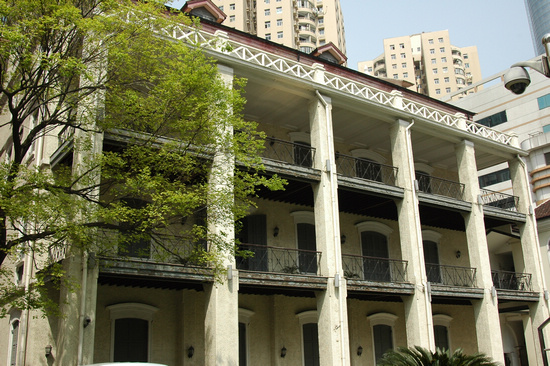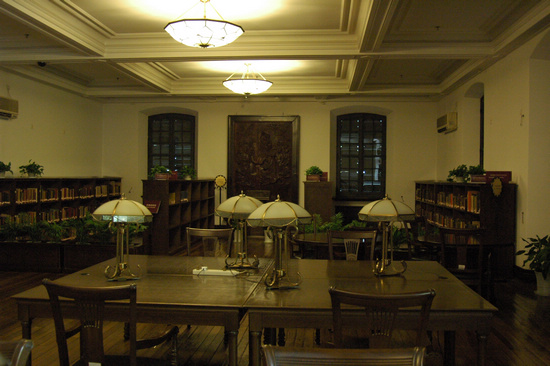|
By Hu Min | May 6, 2015, Wednesday TRACING her family tree, Sue Morrell Stewart found her roots in China’s first English-language newspaper. The 56-year-old South African teacher came to Shanghai last week to delve into archives of the North China Daily News, which began publication in the city in 1850 and survived for 101 years. Stewart’s British great-great-grandfather, G. W. Haden, was an editor at the newspaper during the era of the British concession in the late 1800s. Her interest in genealogy was piqued by her grandmother, who, as she lay dying in South Africa, told her son for the first time that she had been born in China. Stewart’s father, now 88, was fascinated by the discovery and began contacting places that might have some information about his ancestors’ past. He even went to England in search of his roots. Little was found. Stewart became captivated by his quest and began doing her own research. Using his notes, she had the name of David Martin and a surname of Haden as pieces of the China portion of the family tree. “She loved China, but she never talked about it,” Stewart said of her grandmother. “Looking back, that is very sad.” After her husband, a newspaper editor in South Africa, died last year, Stewart’s interest in fulfilling her father’s dream of tracking the family tree prompted her to take a job teaching English in the Shandong Province city of Qingdao in January. In late April, she sent an e-mail to Shanghai Daily asking if the paper, by any chance, had access to the archives of the North China Daily News. Shanghai Daily told her that the only archives available were stored at the Xujiahui Bibliotheca, Shanghai’s oldest library. She made a beeline for the library when she arrived in the city. It was impossible to read all the issues of a century’s publication, but Stewart managed to read some of the papers published during the era when she thought her ancestors lived in the city. “It’s important for us to know about our roots,” she said. “My father will be very appreciative and happy when I tell him what I have learned.” Stewart also visited the Shanghai Archives during her stay in Shanghai but found no relevant materials there. The search is complicated by her inability to speak or read Chinese. The limbs of the tree that she did manage to find in Shanghai point to a fascinating family saga. Stewart’s great-grandfather David Martin (1840-1907), who married Haden’s daughter Mary, was once the captain of the “Tatung,” a steamship owned by Butterfield & Swire Shipping Co. He spent many years in Shanghai, where his daughter Charlotte was born in 1898. Charlotte was sent to boarding school in England when she was 8 and never saw her father again. He died a year after she left. On a ship voyage later in life, Charlotte met a British man who worked in South Africa. They married and spent their honeymoon in China in 1925. Those were the easy pieces of the puzzle. Searching for more detail was more difficult. Many materials related to China were destroyed during wartime or by fire, Stewart said. At the Xujiahui Bibliotheca, Stewart looked for certificates of births, deaths or marriages of ancestors in China. “We knew nothing about Haden, not even his full name, his birth date, whom he married or when he died,” she said. “My father only knew from what his mother told him that Haden was editor of the Shanghai newspaper at some stage, so we thought the paper might record some of the family’s vital statistics.” After hours of work, Stewart found a small death notice for David Martin, who died in 1907. She also found a series of booklets, published by North China Daily News, listing foreign companies operating in Shanghai. There she found mention of a man named G. W. Haden, who was an editor at the newspaper. Haden’s name appeared in several booklets in the annual series, then disappeared in the late 1880s. Stewart surmises he might have died. “My father had been trying to find out information for many years,” she said. “I wanted to do this before he dies. It is really good that we now probably know of G. W. Haden and that he was an editor on the paper.” The North China Daily News has a history equally interesting. It was founded by British auctioneer Henry Shearman in 1850, the first English-language newspaper in China. It was influential in its time, with circulation peaking at almost 8,000 copies a day. It was closed in 1951. Finding an ancestor so closely associated with Shanghai history isn’t enough for Stewart. She said the search for more information goes on. “I was hoping for more, I must say,” she said. “I really wanted to learn more about the women in both of those men’s lives — my great-grandmother and my great-great-grandmother. I was hoping to find some photos.” She said she left her details at the Shanghai Archives, where staff promised to notify her if they came up with any material that might further her search. Anyone wishing to contact her can e-mail smorrellstewart@gmail.com. (Source: ShanghaiDaily.com http://www.shanghaidaily.com/metro/entertainment-and-culture/South-African-woman-searches-for-clues-to-her-Shanghai-roots/shdaily.shtml )
The Bibliotheca Zi-Ka-Wei (The Xujiahui Library)
• Historical background The Bibliotheca Zi-ka-wei on the present premises consists of north and south buildings. On the north side is a two-story European-style brick and timber structure, built in 1897 used for stack rooms, which were divided into the Chinese collection on the first floor and western-language on the second, giving the name "Bibliotheca Major"; the other on the south is called the "Jesuit Residence", originally erected in 1867 and then expanded and renovated into a four-story mansion in 1931. In 1956, the Bibliotheca became a branch of the Shanghai Library, when some other unique libraries, such as the Royal Asiatic Society North-China Branch Library, the Haikwang Western Thoughts Library, the International Institute of China Library and the Shanghai Municipal Council Public Library, were merged. In 2003, the Bibliotheca Zi-ka-wei was renovated and re-opened after being temporally brought to a close to make way for the early municipal metro line construction. The Bibliotheca has now resumed her services for users and become a new local landmark around the area as well as a highlight of cultural life for people of the city and even the country. The original old western collection, the custody of human heritages of western theology and sinology on the second floor of the north building "Bibliotheca Major", is an imitation of the Vatican library, with all the books organized in a strict conformity with the Vatican classification system in 36 main categories and 286 sub-categories.
• Collections and Services The Shanghai Library boasts of 750,000 volumes of old foreign publications, published from 1477 to 1950, among which 320,000 volumes are collected in the current site of Bibliotheca Zi-ka-wei. The collections involve nearly 20 different languages, including Latin, English, French, German, Russian, Japanese and so forth, covering such disciplines as philosophy, religion, politics, economy, linguistics, literature, art, history, geography to name a few. Among them, pre-1800 rare editions in western languages, early Russian and Japanese documents, materials on Catholic theology and sinology are mostly treasured. • Opening hours: |



